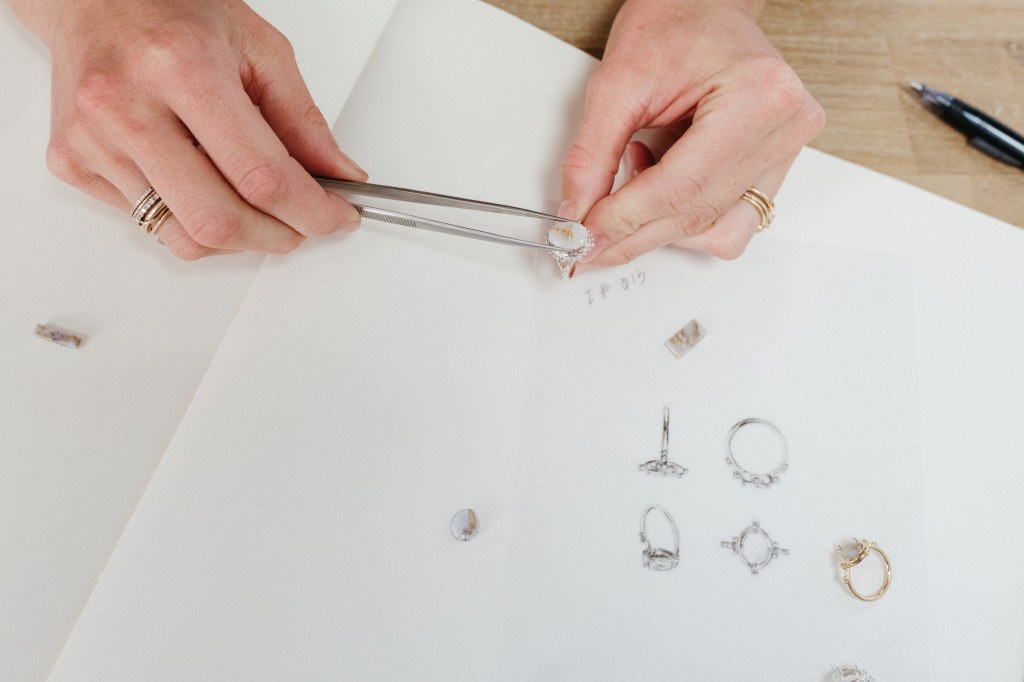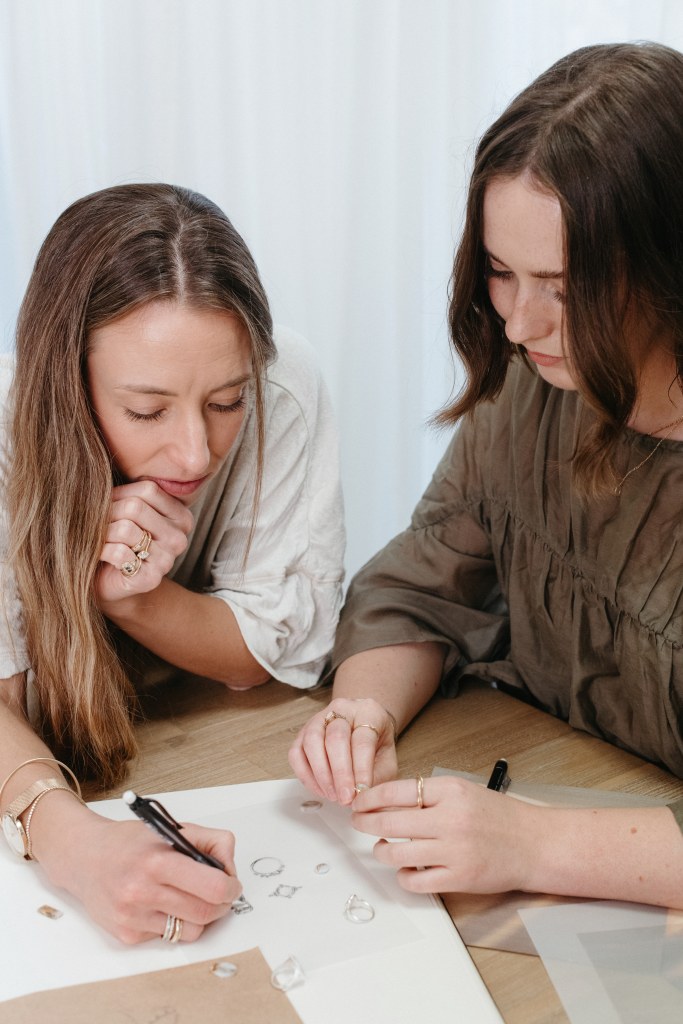Natalie Fitch decided to be transparent about costs and where the money goes in her jewellery designs, but not everyone was happy.
Key Takeaways
- 2022 marks the 10th anniversary of the business’ first collection
- The company has pivoted from the wholesale model to direct-to-consumer, a move it believes is more sustainable
- To produce one 0.33 ounce 18-karat gold ring, 20 tonnes of toxic waste is generated

Most jewellers enter the trade to carry on a family tradition of the art, but Natalie Marie Jewellery’s owner, director and head designer, Natalie Fitch did it the new-school way, by studying at university.
It was a little left field for Fitch, who initially moved to Sydney from England when she was 20 years old to study marine science.
“My creative side was kind of perceived as a nice hobby, or nice thing to do on the side – but it never carried much weight throughout my education,” she says. Her creativity became a bit of a running joke: “If there’s an empty egg carton or something, [my family would] say, ‘oh better save it for Nat,’ because I’d always be turning things into something else.”
After about six months of marine science, Fitch met her then-boyfriend, now-husband-and-business-partner, who was a fashion designer at the time. He inspired her to turn her hobbies and passions into a career, and she transitioned into a fine arts degree, majoring in jewellery-making.
“I think some people in the industry felt a bit betrayed by someone being transparent.”
– Natalie Fitch, founder of Natalie Marie Jewellery
Now, Fitch and her husband run Natalie Marie Jewellery, a handcrafted, fine and bespoke jewellery business. It’s in its 10th-ish year of business (2022 officially marks the 10th anniversary of the business’ first collection, but there were hard yards before), with around 40 full-time staff. It has a bricks-and-mortar presence in Avalon, New South Wales, but its online store is where the cult flocks. The Natalie Marie Jewellery Instagram page boasts 230,000 followers.
Fitch says at any one time the team is servicing between 600 and 800 clients through its bespoke service, online store and showroom.
“I was not a natural-born jeweller,” she says. “I don’t have the patience – that took me a long time to learn.”
But Fitch was aware she was an outsider to the industry – both metaphorically, coming to the industry with a sense of naivety and openness, and physically, being situated in Avalon and not the CBD. While she’s been welcomed with open arms from the majority of the industry, Fitch says some of her practices have created a bit of tension. Specifically her price transparency model.
In July this year, Fitch’s business released an Impact Report, to help set business benchmarks and guide the company internally, and to also show customers its commitment to sustainability and transparency.
In the report, Fitch included a costing transparency model, which used three jewellery pieces (that are part of the brand’s core collection) to demonstrate where the money goes. Specifically, how much of a markup is put on the item (depending on the item, between 2.3x and 2.8x), and where that markup actually goes (overheads, marketing, GST, reinvestment into business and, of course, net profit).

“I think if we’re going to talk about transparency, it would be remiss of us to not address pricing structure,” she says. “There were people on the team who said, ‘that’s a terrible idea,’ and others who said, ‘I would love to understand that’.”
Fitch says the pricing transparency was the result of a 12-month internal exercise, where the business reviewed every piece, re-vetted every supplier and brought them back on board with a new due diligence toolkit.
“We’ve had to change the supply chain for a few things, which has increased prices in some areas and decreased it in others,” she says.
While customers welcomed the report, the industry did not. “I did get a little bit of backlash from the industry,” she says. “I think some people in the industry felt a bit betrayed by someone being so transparent.”
But Fitch stressed each business’ pricing model would be unique – this was just hers, and it was associated with her own supply chain, and not a reflection of the industry as a whole.
The impact report also marked another major milestone for the business: the end of wholesaling in favour of direct-to-consumer. Initially, wholesaling had represented a big opportunity for Fitch to reach the masses, but after a decade, it was beginning to prove unsustainable (in the environmental sense and the labour sense).
“Larger wholesale accounts have larger production demands and tight deadlines. And also, there’s a real drive to keep the price point down,” she says. “Ultimately, we were either going to have to make some significant compromises on how we produce our pieces band the materials we use, or it just wasn’t feasible.”
The team decided to stay true to their value and ethos, and Fitch’s initial purpose, which was to create pieces for people: “Everything was bespoke, it was designed for that person, sourced for that person. So rather than trying to stretch thinly outwards, we refined our purpose, intention and just really honed in on that with real integrity.”

Of course, Fitch says revenue was impacted to a degree, but given wholesaling margins are tight, it wasn’t a high-profit area of the business to begin with. It’s a gutsy decision, and one that comes with time in industry. After 10 years scaling a local business – and raising two children – Fitch has just that.
She’s also developed a keen eye for greenwashing in the industry. Particularly how terms like ‘recycled materials’ and ‘sustainably produced’ are used, without any real explanation.
Fine jewellery is particularly tricky. A US report shows that to produce one 0.33 ounce 18-karat gold ring, 20 tonnes of toxic waste is generated. Gold mining companies also dump about 180 million tonnes of toxic waste into rivers, lakes and oceans every year – that’s 1.5 times more than the waste that US cities send to landfills.
This has prompted a growing number of jewellery-makers to adopt more sustainable practices, like using recycled materials or lab growing diamonds.
“It’s nuanced and complicated,” she says. “For us, it’s been about doing our due diligence, educating ourselves and understanding these idiosyncrasies. We are fortunate that in Australia, we have some of the world’s highest standards in terms of regeneration and humanitarian elements associated with mining.”
Looking ahead, she has no plans to relinquish that focus – or the company’s initial purpose.
“This is a family business, and we’re very committed to being in the thick of the day-to-day,” she says. “I think we’re ready to expand outside of where we are right now, but just making sure that’s executed in a really careful way. There’s so much room for innovation.”